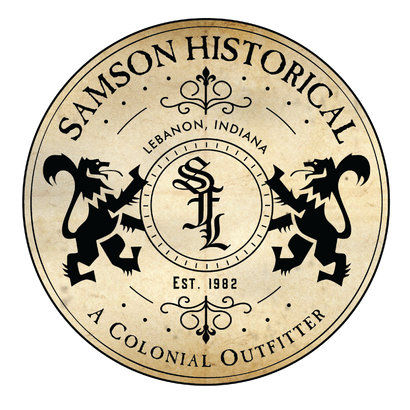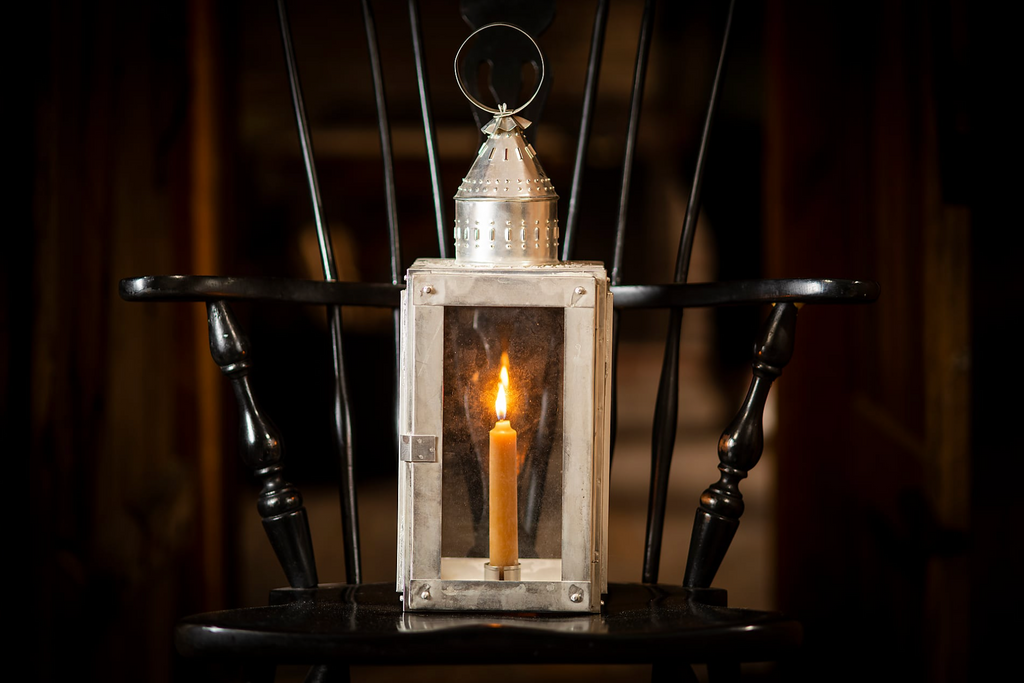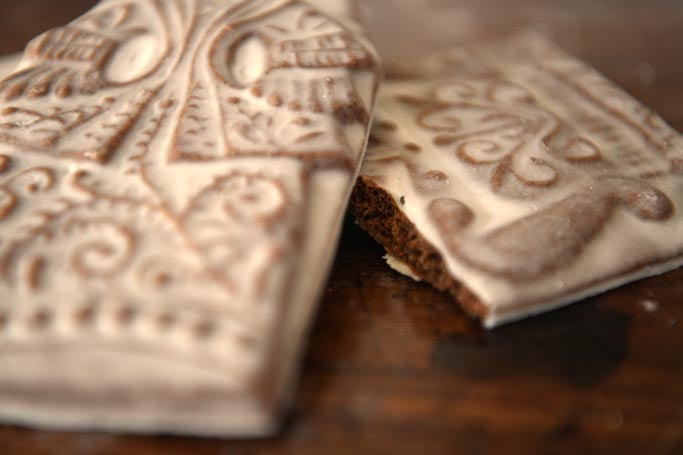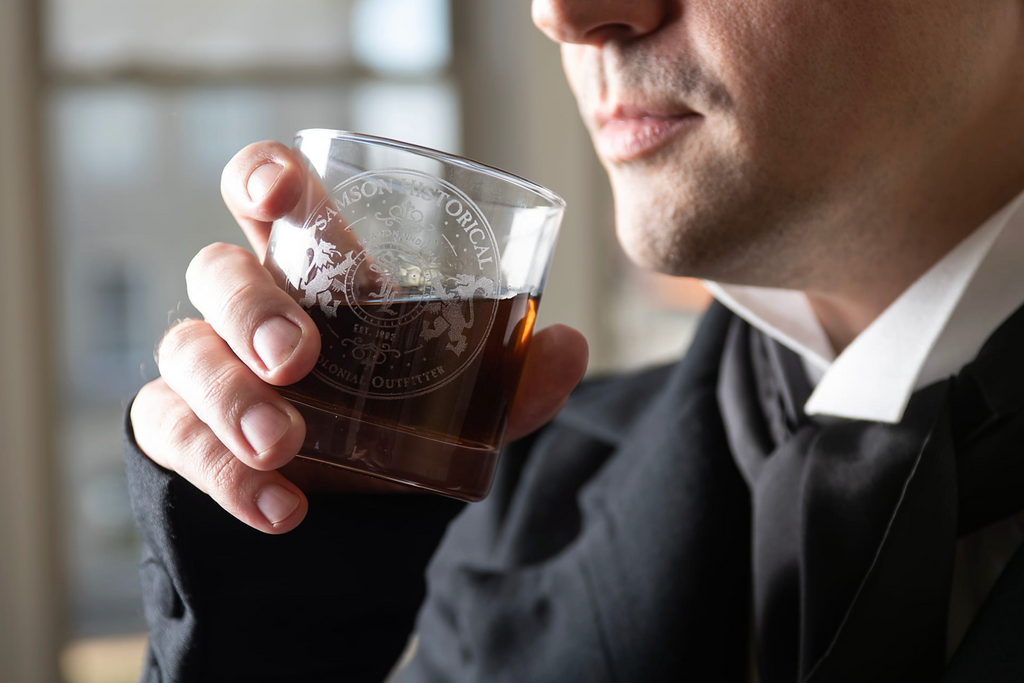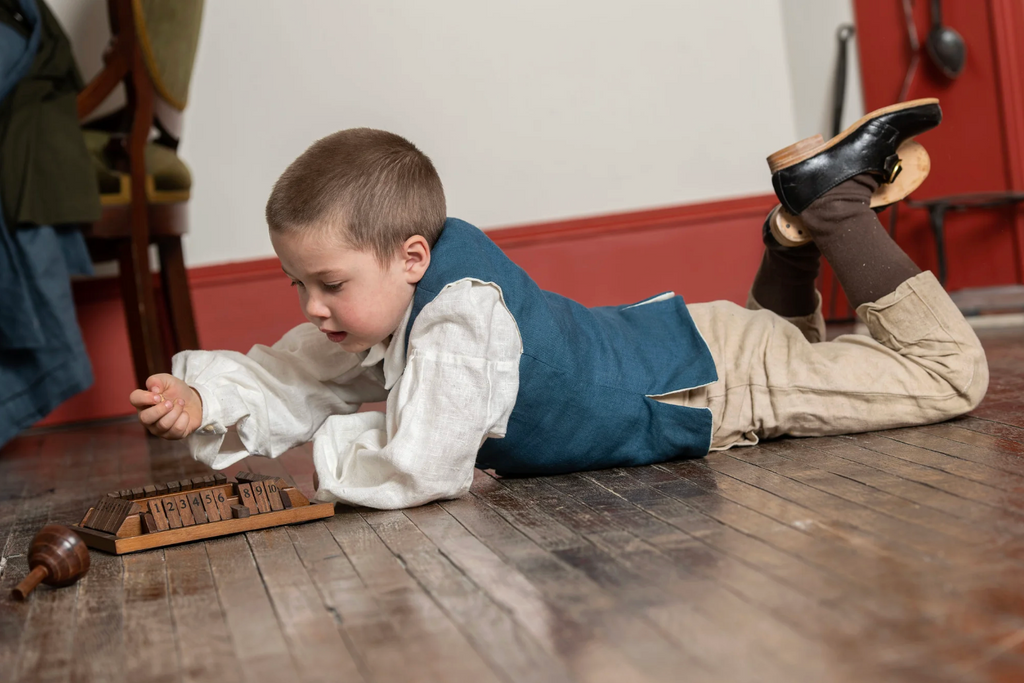Men’s Clothing
Women’s Clothing
Children's Clothing
Fashion Before Ease
by Hannah McIntire 15 min read

By Margaret Bywater
The abdomens of 18th-century American women from all walks of life were bound, literally and figuratively, by stays: stiffened garments worn around the torso to promote straight posture, moral uprightness, and a fashionable figure. Stays were so foundational to 18th-century dress and considered so natural to those who wore them that they were commonly called a “body” or “pair of bodies.”
Before Stays
Although evidence of torso-hugging garments can be found as early as 1799 B.C.E., historians agree that the earliest precursors to 18th-century stays emerged in the 15th and 16th centuries. The European Renaissance saw the emergence of dresses that fit tightly around the torso and laced in the front rather than the sides or back. Another possible ancestor of stays was the Spanish vasquine, a slightly stiffened garment made of two pieces of cloth laced together at the back and front of the abdomen. Both the torso-hugging dresses of the Renaissance and the vasquines of 16th-century Spain were designed to alter the appearance of the wearer’s torso when laced, just as stays did in the 18th century.
In the second half of the 1500s, boning became popular to stiffen the bodices of women’s clothing, bodices that came to be called “stays” in the 17th century. Stays were sewn into the bodices of dresses until the end of the 1600s, when they evolved into a separate undergarment that shaped and supported the abdomen and could be worn under various overgarments.
While a modern audience may be more familiar with the term “corset,” the term did not enter the popular lexicon until the beginning of the 19th century; throughout the 18h century, stiff, boned bodices were referred to as stays, or a pair of bodies.

Who Wore Stays?
Both male and female children from wealthy families began wearing stays around the age of 2, with some starting even earlier. Most boys were taken out of stays when they began to wear breeches, but girls typically wore stays for the rest of their lives. It is important to note, however, that stays meant for young children were looser and much less restrictive than the rigid, boned garments worn by their mothers. Most children’s stays laced in the back, with some featuring “leading strings” on the garments’ shoulders, allowing parents to help a child learn to walk or prevent them from straying too far away. George Washington reportedly wore stays until he was about 5 years old.
Eighteenth-century parents put their toddlers in stays to support healthy development of their spines and postures -- and in the case of girls, to acclimate them to the wearing of more restrictive garments later in life, and to instill in them a sense of modesty and propriety. Some linguists hypothesize that the English word “stays” originates from the Old French verb estayer, meaning “to hold up” or support.
However, the tradition of “swaddling” or “swathing” young children, as the practice of clothing children in stays was then known, decreased in popularity throughout the century, due in part to criticism from doctors like William Buchan, who urged mothers to dress their children in looser clothes. In his book Advice to mothers on the subject on their own health, and on the means of promoting the health, strength, and beauty of their offspring (1804), Buchan writes, “There is not any part of my professional labours which I review with greater pleasure, than my exertions in early life to rescue infants from the cruel tortures of swathing, of rollers, and of bandages … Absurd as we may now think the practice of swaddling and wrapping up a child, till it was as stiff as a log of wood; the arguments in favour of a loose and easy dress … were vehemently combated by most eminent men.”

Childrens’ stays were crafted with the goal of sculpting the wearer’s body into what was considered a healthy and fashionable shape. This included pushing the chest forward, pulling the shoulders back, and keeping the spine straight. As such, stays were considered a key tool in the development of a healthy body, not only in the promotion of healthy growth and posture, but also in the prevention of physical deformities or irregularities. A 1770 advertisement for a New York staymaker illustrates the everyday use of corsets to correct perceived flaws in posture. According to the advertisement, “Any ladies uneasy in their shapes, he likewise fits without any encumbrance; young ladies inclin’d [sic] to casts and risings in their hips and shoulders he likewise prevents.”
Much 18th-century thought surrounding the potential benefits of stays is illustrated in the work of influential French physician Nicolas Andry, who famously published L’orthopedie in 1741. Andry believed that stays counteracted the adverse effects of modern civilization on human posture, noting how a desk’s construction might cause its user to hunch over while reading or writing. He also argued for the respiratory benefits of opening the chest and the aesthetic benefits of smoothing irregularities and dissymmetries in women’s bodies. The belief of Andry and Western society in general -- that stays could help a woman achieve perfection in beauty, health, and balance -- is symptomatic of the Enlightenment ideas that harmony and regularity were the keys to beauty and that humanity can improve itself by emulating the order found in nature.
Most free and non-native women in 18th-century America wore a pair of stays, or “bodies” daily, though not all women wore the same kinds. The tight-laced styles sported by many wealthy women, for whom practicality and comfort was less important than aesthetics and propriety, were impractical for most working-class women. These women often wore plainer stays made of durable fabrics like wool and linen.
Throughout most of the 18th century, it was unusual but not unheard of for adult men to wear stays as well. However, around the turn of the 19th century, it became more popular for intellectual men to wear stays to create the appearance of a small waist and slender back and to encourage upright posture.
Most enslaved women in America did not wear stays. Instead, many women who worked in the fields wore only plain dresses similar to the other women on the plantation. An advertisement soliciting the capture and return of an escaped slave in a 1766 issue of the Virginia Gazette describes a woman named Alice, “clothed in Negro cotton.” According to historian Linda Baumgarten, plantation records “reveal that the summer clothes of many female slaves consisted only of a linen shift and somewhat heavier linen petticoat,” though most women “(would) not leave the privacy of her own upstairs in this comparative state of undress.”

However, there is evidence that some enslaved women did wear stays, especially those assigned to work in the home rather than outdoors. An advertisement placed in the Virginia Gazette by slaveholder Paul Heriter on April 18, 1766, describes an escaped slave woman named “Agnes or Agie” who “had on when she went away ... a pair of stays with fringed blue riband,” among other garments.
Like white women, free women of color wore stays according to their wealth and status. In a famous painting by Johann Zoffany, Dido Elizabeth Belle -- an English heiress of mixed racial ancestry -- is pictured beside her white cousin and companion Elizabeth Murray. The two are dressed quite similarly. Although Belle’s torso is mostly obscured, she appears to be wearing a proper set of stays under a gown of expensive silk or satin, an ensemble fitting of her noble status and her family's considerable wealth. A 1773 portrait of another free black woman -- poet, and former slave Phillis Wheatley -- shows the writer dressed appropriately, though modestly, in a bonnet, shawl, and a dress, which is likely covering a pair of stays.
Stays and Pregnancy
Many women continued to wear stays during pregnancy and after childbirth. A pair of stays from the Colonial Williamsburg Collection, dated between 1770 and 1780, features square flaps at the breasts, possibly to accommodate breastfeeding. Stays laced at the front, back, and sides were easily adjusted to the wearer’s growing stomach.
However, when at home, “(pregnant) women of all classes … donned unboned sleeveless bodices, quilted or corded to support the belly and breasts. Working-class women had the added choice of loose, unconstructed jackets called ‘bed gowns’ over a petticoat,” according to Valerie Steele’s The Berg Companion to Fashion. These less rigid bodices could also be worn in conjunction with a pair of fully boned stays for added warmth during the winter.
In an article for the Colonial Williamsburg Journal, Baumgarten quotes a 1735 letter from Sarah, Duchess of Marlborough, in which the author describes how she substituted her stays for more forgiving garments during pregnancy. She writes, “I remember when I was within three months of my reckoning, I could never endure any bodice at all; but wore a warm waistcoat wrapped about me like a man’s and tied my petticoat’s on top of it. And from that time never went abroad but with a long black scarf to hide me I was so prodigeous (sic) big.”
Other women, especially in the second half of the century, believed that wearing stays during pregnancy might cause skeletal deformities in the infant. In a book by British author John Hill, a woman writes, “There are Countries where children are all born strait, [sic] and with a Tendency to Straitness; and being not injured by the Practices of their Nurses and Mothers, they continue so. The great Reason why these Children are born strait, is, that their Mothers wear no Stays.”

How Stays Were Made
Most professional staymakers in the 18th century were men who began learning the craft in early adolescence. English-American political thinker Thomas Paine was the son of a staymaker and began training in the craft by the age of 12 or 13 when he was taken from school and made an apprentice to his father. However, it seems Paine did not take to the profession and abandoned stay-making in early adulthood. Unfortunately, Paine’s early profession was a source of ridicule from those who disapproved of his political ideas and wished to mock and discredit him; in a slanderous 1796 biography of Paine published under the pseudonym Francis Oldys, Scottish writer George Chalmers mocked his stay-making profession to undermine the soundness of his political ideology. Oldys implied that Paine’s working-class vocation made him unfit to participate in politics.
Male craftsmen dominated the stay-making industry. Though a girl may be apprenticed to a staymaker, few became master staymakers. According to a dissertation on 18th-century stays by Samantha Hall Dorsey, “master stay makers were overwhelmingly male … Women and young girls were hired in stay makers shops, however, they were deliberately deskilled and relegated to plain sewing.” Thus, female employees of stay-making shops were primarily seamstresses. A few 18th century stay-making shops were run by widows who inherited the business when their husbands died or started their stay, making businesses earn an income. Not all stays were made in shops. Women who could not afford or did not wish to pay for professionally made stays might purchase materials from a local staymaker and construct the garment themselves.
Stays were made of three structural layers: the outer lining, the inner buckram, and the stays themselves, strips of sturdy yet flexible material that maintained the shape and rigidity of the garment. Depending on the desired appearance, quality, and price of the stays, the outer layer might be made of linen, wool, silk, or other fabrics and was sometimes intricately embroidered but was most often left bare. The middle layer of the stays was made from buckram, a general term for stiff fabrics such as thick linen or canvas that reinforced the structure of the stays and dispersed pressure across the torso. This made the stays more comfortable and extended the life of the garment by relieving tension from the seams.


Beneath the buckram layer were the strips of boning, inserted into the front of the stays to keep the chest flat and straight, in keeping with the fashionable silhouette of the time. Though sometimes made of cheaper materials like thread, wood, or reeds called “canes,” stay boning was most commonly made from baleen, or “whalebone,” harvested from the mouths of baleen whales, especially bowhead whales. An additional piece of rigid material called a busk was inserted in the center front of the stays to further ensure that the garment lay flat against the body. Baleen was considered the best material for the construction of stays because it was made of keratin, the same protein that forms human hair and nails, and was therefore both flexible and durable. Wood was a less suitable material for stay boning and busks because it warped quickly with moisture and wear.
In the late 18th century, some seamen who worked on whaling boats passed the time by carving baleen busks for female loved ones, especially their wives or sweethearts. Such busks might be engraved with floral patterns, mythical scenes, personal messages, or even poetry.
The busk could be easily inserted into a pair of stays through a pocket of fabric called a buck sheath. On front-laced stays, it would lay alongside the ribbon and span the height of the corset from the center of the bust to the pubic bone. In this way, 18th -century women could keep their seafaring beloveds close to their hearts, both literally and figuratively. This art of carving and engraving baleen or whale ivory came to be called “scrimshaw.”
Baleen strips were strategically arranged to mold the wearer’s torso into the fashionable shape of the time, which favored a small waist, flat stomach, straight posture, and prominent, lifted bosom. Some stays had straps (or more rarely, sleeves) over the shoulders to further encourage straight posture by holding the shoulders back and pushing the chest forward. Most stays also had tabs over the hips to allow the wearer mobility in the legs while pushing the hips back to achieve further the straight, chest-driven posture that was fashionable in the 18th century. These tabs may have also been stitched with small holes to allow for the attachment of hip pads, or rumps, a roll made of linen, cotton, cork, or crin (horsehair) worn under petticoats to fashionably emphasize the hips and rear in the last quarter of the century. A fashionable pair of stays also featured a point at the bottom of the bodice, often reaching several inches below the wearer’s natural waist.
Before a pair of stays could be considered finished, a staymaker would call their customer in for a fitting to ensure that the stays fit snugly but comfortably around the wearer’s abdomen. Since stays were worn every day and were meant to be tightly fitted, it was important that the stays be specially molded to the wearer’s abdomen to ensure the most comfortable fit possible. If the stays did not fit as desired, the staymaker would make final adjustments to the garment before giving it to the customer. Often, the fit of whalebone stays would improve with frequent wear as the keratin molded to the particular curves of the wearer’s body. A typical pair of baleen stays lasted about six years.
How were stays worn?
A pair of stays was typically worn over a chemise, a plain underdress that separated the stays from the skin of the wearer. This promoted the comfort of the wearer and protected the stays from the natural sweat and oils of the body. Since many women in the 18th century had very few dresses and stay, it was important to keep them clean, especially since frequent washing could diminish a garment's longevity.
Stays were secured in place with a ribbon and were most commonly laced in the back, though stays could also be laced in the front or in both the front and back. Women who preferred front-laced stays may have done so because they made it easier for the wearer to put on the stays themselves, especially if they did not have family members or servants who could help them dress. The chests of some back-laced stays were decorated with ribbon to give the appearance of a front-laced bodice. Some stays also had lacing under the arms to accommodate weight gain during pregnancy or otherwise the natural fluctuation of body shape and size; adjustable stays were a practical way to save money on clothes while staying fashionable, proper, and supported.
Often, a triangle piece of fabric called a “stomacher” was worn in front of the stays, covering the gap in the front of a woman’s jacket or gown, though stomachers became less popular at the end of the century as the fashionable silhouette grew softer and less conical.
Lower and middle-class women sometimes shed overgarments such as gowns or shortgowns while they worked, making the stays a visible piece of clothing. English artist Paul Sandby often depicted working women in their stays, as in his work “Two Girls Seated.” A print of the 1749 engraving “The Merchant Taylors'' by Louis Phillipe Boitard prominently shows a woman (presumed to be a seamstress or other type of employee) walking across a busy shop with her stays on display. However, it would have been considered grossly improper for a woman of status to show her stays in public.

Stays as Fashion
In her book, The Politics of Fashion in Eighteenth-Century America, historian Kate Haulman notes, “Beginning in the early 1730s, stay makers … were the first advertisers in Philadelphia to place advertisements that used the term’ fashion,’ a fact which reveals the extent to which stays were not only utilitarian undergarments but also an integral part of the fashion of the day. As the bodice’s primary structure, a pair of stays determined much of the silhouette of a dress, and therefore much of its overall effect.
Wanting to emulate the modern, ever-changing styles of European dress, American women and staymakers (as well as stylish American men) took their fashion cues from London, who in turn looked specifically to Paris for the newest styles. An advertisement for the stay-maker Richard Norris that appeared in the New-York Journal on January 11, 1770, emphasizes London fashions’ knowledge and practices the staymaker’s most important selling point. The ad announces that Norris works “by methods approved of by the society of stay-makers in London: he acquires the first fashions of the court of London, by a correspondent he has settled there. He has had the honour of working for several ladies of distinction, both in England and in this city, with universal applause, and flatters himself he gave entire satisfaction.”
In a 1782 issue of Felix Farley’s Bristol Journal, there is an advertisement for French staymakers P. Brickman and N. Coppin in Bath and Bristol's English cities. The advertisement emphasizes their connections to Paris, broadcasting the craftsmen’s ability to “make all sorts of STAYS, half Bone STAYS, CORSETS, Riding WAISTCOATS, and CORSETS A-LA-REINE ... after the newest Taste from Paris and London.”
Due to the relatively slow travel of information in the 18th century and America’s considerable distance from Paris’ and London’s European fashion centers, fashionable American women were often later to adopt new trends than their counterparts in England and France. However, many American women did their best to dress fashionably, both out of personal aesthetic interest in clothing and the knowledge that an out-of-date appearance could denote a lower social or economic status than they wished to portray.
Throughout most of the 18th century, stays covered the entire abdomen, sometimes extending below a woman’s natural waist. Until the last quarter of the century, stays remained largely unchanged, consistent foundations for the more capricious styles of sleeves, skirts, and embroidery of the overgarments. Beginning in the 1780s, however, the fashionable waistline rose slowly until it reached the bottom of the bust in the early 19th century. Stays adapted accordingly, growing steadily shorter and less boned as the years progressed.
The Discourse Around Stays
In the 18th century, the wearing of stays was not only associated with a woman’s beauty and health, but also with her virtue. As such, a woman who did not wear stays risked damaging her reputation with sexual looseness and gluttony associations. A satirical 1724 poem titled “A Lover to His Fat Mistress Without Stays” illustrates the cultural link between stays and moral propriety, reading, “Pray charming Silvia, do not think you raise / My modest Passion by your want of Stays ...You look like one from Vertues [sic] Bonds just freed, / Whose Dress declares you little Courtship need … But if you think my jealous Eyes to please, / And would be gently Conquer’d by degrees, / Raise my Esteem, and make me speak your praise, / Pray hide the Slit, and hasten on your Stays.”
In October 1774, Virginian tutor Philip Vickers Fithian humorously wrote in his journal, “To day (sic) I saw a Phenomenon, Mrs. Carter without stays!” For 18th-century Americans, stays were the “body” of a woman, and without them, she was naked, even when wearing a shift or a chemise.
Just as a woman could be ridiculed for being seen without her stays, she could also be criticized for wearing her stays too tightly, which some considered a sign of vanity. The practice of tightlacing, in which fashionable women tightened their stays so intensely that it restricted their breathing, were a popular subject of satirical poems and cartoons. English cartoonist John Collet satirized the phenomenon in a piece dated to around 1770 titled TIGHT LACING, or FASHION before EASE, in which the ribbon on a young woman’s corset is pulled tight by three other people, including her husband, a woman presumed to be a relative or servant, and a black servant boy.
Some early feminists argued that stays, especially the tight-laced styles popular among the elite, contributed to the subjugation of women. In her 1792 philosophical manifesto A Vindication of the Rights of Women, influential British thinker Mary Wollstonecraft wrote, “Most men are sometimes obliged to bear with bodily inconveniences, and to endure, occasionally, the inclemency of the elements; but genteel women are, literally speaking, slaves to their bodies, and glory in their subjection.”
However, there is little evidence to support that most women resented their stays, even those who chose to wear them tight-laced. There is little contemporary writing about stays at all, as a ubiquitous undergarment taken for granted and seldom thought of, in some ways akin to the modern bra. Since stays were at once mundane and erotic, public and personal, there is relatively little written about them by the people who wore them. So it is difficult to draw any conclusions about the general attitudes of women towards stays other than that most women who wore stays regarded them with relative indifference, and took them as a natural part of life. Baumgarten notes, Although some criticized stays prior to the 1790s, Baumgarten notes, “the most vocal outbursts against them occurred after stays had been abandoned for fashionable reasons,” at the end of the 18th century.


Need your own pair of stays? Click here to browse our selection!
Leave a comment
Subscribe
Sign up to get the latest on sales, new releases and more …
